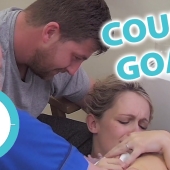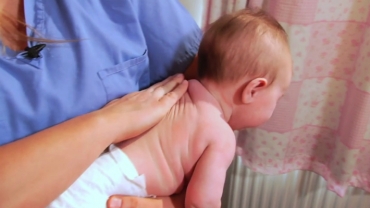Overwhelmed by the conflicting and often confusing advice about how to breastfeed your baby? Watch this video and observe a gentle, yet simple approach to breastfeeding with The Thompson Method.
• Cradle your baby in your arm, elbows relaxed by your side.
• Gently roll your baby to face your breasts.
• Guide the lips over your nipple (not nipple to nose)
• Allow time for your baby's mouth to open naturally.
• Drawing the nipple and some breast tissue (often referred to as latching or attaching).
• Avoid holding your baby by the back of the head, neck or shoulders.
• Research Finding: You are 2 times more likely to experience nipple pain or damage if you hold your baby by the back of the head, neck or shoulders.
• Observe that the nostrils, the chin and both cheeks are in contact with your breast.
• This is called Face to Breast Symmetry.
• The nostrils contour the shape of your breast.
• The chin massage is deep in the breast.
• And both cheeks are snug at the breast.
• Research Finding: When one or more of the facial points is not in contact with your breasts, you are 4 times more likely to experience nipple damage.
• You can gently fine-tune your baby to achieve Face to Breast Symmetry.
• Move your baby slightly right or slightly left so that the nostrils and chin are in contact.
• Move your baby slightly over or slightly under so that both cheeks are in contact.
• Observe your baby stimulating your breast to start the milk flow.
• These short 'start-stop' rhythms actually stimulate hormones for milk production.
• When the milk starts to flow your baby starts to swallow.
• Observe the change to a longer, deeper 'draw- swallow' rhythm.
• When satisfaction has been reached your baby's behavior will become more relaxed.
• When the stomach is full, your baby may nurture at your breast.
• This nurturing time allows your baby to reach nutritional and emotional satisfaction.
• The vacuum inside your baby's mouth gradually releases.
• Allowing your baby to gently slip off your breast.
• After the first breast, give your baby time to rest and digest.
• This time will help avoid reflux and colic.
• Observe your baby stretching the arms and legs allowing the air to rise.
• This helps the digestive process.
• Towards the end of the rest and digest period your baby will become more active.
• Observe your baby's cues indicating when ready for the second breast.
• These cues include the arms and legs moving, smelling, tasting, touching, the tongue protruding and lastly, the voice calling.
• So, when ready for the second breast gently cradle your baby and repeat as for the first breast.
• One satisfaction has been reached from the second breast.
• Hold your baby up right.
- 6273 views













